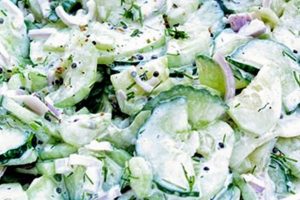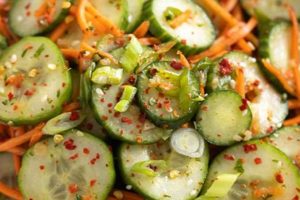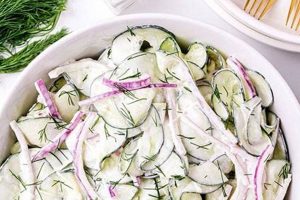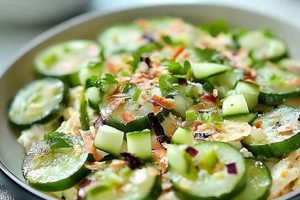A refreshing and tangy dish, this type of salad typically combines thinly sliced cucumbers and onions marinated in a vinegar-based dressing. Variations can include the addition of herbs, spices, peppers, or sweeteners to create diverse flavor profiles. A simple example involves slicing one cucumber and one small red onion, then tossing them with a mixture of 1/4 cup white vinegar, 2 tablespoons water, 1 tablespoon sugar, and a pinch of salt. Allowing the mixture to rest enhances the flavors as the vegetables release their juices and absorb the dressing.
This salad offers several advantages. Its simple preparation requires minimal ingredients and time, making it a convenient side dish. The vinegar base contributes a tangy flavor that complements richer dishes, while the hydrating vegetables offer a refreshing counterpoint. Historically, such salads have served as a practical way to preserve vegetables, particularly during warmer months when refrigeration was less accessible. The acidic environment created by the vinegar inhibits bacterial growth, extending the salad’s shelf life.
The following sections will explore variations on this classic preparation, including specific ingredient recommendations, detailed instructions, and suggestions for complementary dishes. Topics will also cover nutritional information and techniques for achieving optimal flavor and texture.
Tips for a Perfect Cucumber and Onion Salad
Achieving optimal flavor and texture in this simple salad relies on a few key techniques. Attention to detail in ingredient selection and preparation can elevate the dish from ordinary to extraordinary.
Tip 1: Salt the Cucumbers: Salting cucumbers prior to mixing helps draw out excess moisture, resulting in a crisper texture and preventing the salad from becoming watery. Sprinkle sliced cucumbers with salt and let them sit for 15-20 minutes before rinsing and drying.
Tip 2: Thinly Slice the Vegetables: Uniformly thin slices ensure even marinating and a pleasant mouthfeel. A mandoline slicer or sharp knife is recommended for achieving consistent thinness.
Tip 3: Balance Sweetness and Acidity: The ratio of vinegar to sweetener plays a crucial role in the final flavor profile. Experiment with different types of vinegar and sweeteners to achieve the desired balance. A general guideline is a 2:1 ratio of vinegar to sugar.
Tip 4: Choose the Right Vinegar: White vinegar offers a classic, sharp flavor, while apple cider vinegar provides a slightly sweeter, mellower taste. Rice vinegar contributes a subtle sweetness and works well in Asian-inspired variations.
Tip 5: Add Herbs and Spices: Fresh dill, parsley, or chives can enhance the flavor complexity. A pinch of red pepper flakes adds a touch of heat.
Tip 6: Marinate for Optimal Flavor: Allowing the salad to marinate for at least 30 minutes, or even longer in the refrigerator, allows the flavors to meld and the vegetables to absorb the dressing fully. Peak flavor is typically achieved after a few hours.
Tip 7: Consider Adding Other Vegetables: Bell peppers, tomatoes, or thinly sliced carrots can add color, texture, and nutritional value.
By following these tips, one can create a flavorful and refreshing salad that complements a variety of meals. Attention to these details elevates a simple combination of ingredients into a truly enjoyable culinary experience.
The following section will provide a collection of recipe variations that demonstrate the versatility of this classic dish.
1. Ingredients
Ingredient selection significantly impacts the final flavor profile and overall quality of a cucumber, onion, and vinegar salad. The foundational componentscucumbers, onions, and vinegarestablish the basic character of the dish, while supplementary ingredients offer opportunities for customization and complexity. For instance, using English cucumbers, known for their mild flavor and thin skin, yields a delicate salad, whereas Kirby cucumbers contribute a more pronounced, slightly sweet taste. Similarly, red onions impart a sharper, more pungent flavor compared to the sweetness of Vidalia onions.
The choice of vinegar also plays a crucial role. White vinegar provides a clean, sharp acidity, while apple cider vinegar introduces a subtle sweetness and fruitiness. Rice vinegar offers a mild, slightly sweet tang, complementing Asian-inspired variations. Beyond the core ingredients, additions such as sugar, salt, pepper, herbs, and spices further shape the flavor profile. Fresh dill, for example, adds an herbaceous, slightly anise-like note, while a pinch of red pepper flakes introduces a touch of heat. The quantity of each ingredient influences the overall balance; adjusting the amount of sugar alters the sweetness level, while varying the amount of vinegar modifies the acidity.
Careful consideration of ingredient selection empowers one to craft a salad tailored to specific preferences. Understanding the characteristics of each component allows for precise control over the final flavor profile, transforming a simple combination of ingredients into a customized culinary experience. Selecting fresh, high-quality ingredients ensures optimal flavor and texture, elevating the salad from ordinary to exceptional.
2. Preparation
Proper preparation techniques are essential for maximizing the flavor, texture, and overall quality of a cucumber, onion, and vinegar salad. While seemingly simple, attention to detail in each step significantly impacts the final result. From the initial slicing of vegetables to the final mixing and marinating, careful execution enhances the salad’s appeal.
- Slicing Techniques
Uniformly thin slices ensure even marinating and a pleasant mouthfeel. Thinly sliced cucumbers and onions readily absorb the dressing, resulting in a more flavorful and evenly seasoned salad. In contrast, thick or unevenly cut pieces can lead to an imbalance of flavor and a less appealing texture. Using a sharp knife or mandoline slicer facilitates consistent slicing.
- Salting Cucumbers
Salting cucumbers prior to incorporating them into the salad draws out excess moisture. This process prevents the salad from becoming watery and maintains the cucumbers’ crispness. After salting, rinsing and thoroughly drying the cucumbers ensures the dressing adheres effectively. This step contributes significantly to the salad’s overall texture and prevents dilution of the dressing’s flavor.
- Maceration and Marinating
Macerating the onions, by soaking them briefly in cold water, mellows their sharp flavor, especially for varieties like red onions. Marinating the combined vegetables in the vinegar-based dressing allows the flavors to meld and intensify. The duration of marination influences the intensity of the final flavor, with longer periods resulting in a more pronounced vinegar tang and deeper integration of flavors.
- Order of Combination
The order in which ingredients are combined impacts the final product. Adding delicate herbs at the end prevents them from wilting or becoming overly saturated with vinegar. Combining the cucumbers and onions before adding the dressing ensures even distribution and prevents one vegetable from dominating the flavor profile. This approach contributes to a balanced and harmonious final dish.
Precise execution of these preparatory steps elevates the cucumber, onion, and vinegar salad from a simple side dish to a more refined culinary creation. Attention to detail in slicing, salting, macerating, and marinating enhances the salad’s flavor, texture, and overall appeal. These techniques demonstrate that even simple dishes benefit from careful preparation.
3. Flavor Balance
Flavor balance is paramount in a successful cucumber, onion, and vinegar salad. The interplay of primary tastessweet, sour, salty, and bitterdetermines the overall palatability. This salad inherently possesses a prominent sourness from the vinegar and a subtle bitterness from the onion. Careful balancing of these elements with sweetness and saltiness is crucial. Excessive acidity can overwhelm the other flavors, rendering the salad unpleasantly tart. Insufficient acidity, conversely, can result in a bland, uninteresting dish. For instance, a salad made with only white vinegar and no sweetener may be too sharp, while one with an overabundance of sugar can taste cloying and mask the freshness of the vegetables.
The type of vinegar employed contributes significantly to the flavor profile and requires corresponding adjustments to other ingredients. A milder vinegar, such as rice vinegar, necessitates less sugar compared to a sharper white vinegar. Salt acts as a flavor enhancer, accentuating the other tastes and providing a savory counterpoint to the sweetness and acidity. The quantity of salt must be carefully calibrated to avoid over-salting, which can obscure the delicate flavors of the cucumbers and onions. Real-world examples illustrate this balance: a classic American-style cucumber and onion salad often incorporates granulated sugar to offset the sharpness of white vinegar, while a German gurkensalat might use a touch of dill and a smaller amount of sugar to complement the milder apple cider vinegar. These variations demonstrate the adaptability of the basic recipe and the importance of tailored flavor balancing.
Understanding the interplay of these flavors allows for precise control over the final taste. The goal is not to eliminate any single taste but to create a harmonious blend where each element complements the others. Achieving this balance requires careful consideration of ingredient ratios and an awareness of how different vinegars, sweeteners, and seasonings interact. Mastering this aspect of the recipe enables the creation of a consistently delicious and refreshing salad suitable for a variety of palates and occasions. The practical application of this understanding empowers one to confidently adjust the recipe based on personal preferences or available ingredients, ensuring a consistently enjoyable culinary experience.
4. Serving Suggestions
Serving suggestions enhance the versatility of the cucumber, onion, and vinegar salad, transforming it from a simple side dish to a key component of diverse meals. Understanding complementary flavor profiles and textures allows for strategic pairings that elevate the dining experience. Consideration of cultural influences further broadens the salad’s application.
- As a Side Dish
The salad’s refreshing acidity and crisp texture provide a counterpoint to rich, savory dishes. Grilled meats, such as steak or barbecued chicken, benefit from the salad’s bright, cleansing qualities. Fried foods, like fish and chips or schnitzel, find balance with the salad’s lightness. Hearty stews and casseroles gain a refreshing contrast, cutting through the richness of these dishes. Examples include serving the salad alongside grilled salmon, pairing it with fried chicken, or complementing a beef stew.
- In Sandwiches and Burgers
The salad adds a tangy crunch to sandwiches and burgers, enhancing both flavor and texture. Its acidity cuts through the richness of fatty meats and cheeses. The crisp vegetables provide textural contrast to soft breads and fillings. Examples include adding the salad to a pulled pork sandwich, incorporating it into a hamburger topped with cheddar cheese, or using it as a topping for a grilled veggie burger.
- As Part of a Larger Salad
Incorporating the cucumber, onion, and vinegar salad into a larger salad adds a layer of complexity. The vinegar-based dressing can partially replace or complement a traditional vinaigrette. The cucumbers and onions add texture and flavor to mixed greens, tomatoes, and other salad components. Examples include adding the mixture to a Greek salad, combining it with a spinach salad with feta cheese, or mixing it with a chopped Israeli salad.
- Cultural Adaptations
The basic recipe adapts well to different cuisines. In Southeast Asian cuisine, variations often include fish sauce, chili, and peanuts. European versions may incorporate fresh dill or caraway seeds. These adaptations demonstrate the recipe’s inherent flexibility and its ability to complement diverse culinary traditions. Examples include a Vietnamese-inspired salad with fish sauce and mint, a Polish-style salad with dill and sour cream, or a German cucumber salad (Gurkensalat).
These varied serving suggestions highlight the cucumber, onion, and vinegar salad’s adaptability. From a simple accompaniment to a key ingredient within more complex dishes, its refreshing qualities and textural contrast enhance a wide range of culinary creations. Understanding these applications allows for creative integration of this versatile salad into diverse meals, reflecting both personal preference and cultural influences.
5. Variations
The fundamental simplicity of the cucumber, onion, and vinegar salad provides a versatile canvas for culinary exploration. Variations on this classic recipe emerge through ingredient substitutions, additions, and cultural adaptations, demonstrating the dish’s adaptability and enduring appeal across diverse culinary traditions.
- Vinegar Selection
Different vinegars contribute unique flavor profiles. White vinegar offers a sharp, clean acidity, while apple cider vinegar imparts a mellower sweetness. Rice vinegar contributes a subtle sweetness commonly found in Asian-inspired variations. Substituting balsamic vinegar introduces a deeper, more complex sweetness and a darker hue. The choice of vinegar significantly influences the overall character of the salad.
- Sweetener Adjustments
Sugar is the typical sweetener, balancing the vinegar’s acidity. However, variations may incorporate honey, maple syrup, or agave nectar for nuanced sweetness and flavor complexity. Honey adds floral notes, maple syrup imparts a caramel-like richness, and agave nectar offers a milder sweetness. The type and amount of sweetener directly impact the balance and overall taste.
- Incorporation of Herbs and Spices
Fresh herbs and spices introduce aromatic complexity and enhance the salad’s flavor profile. Dill, parsley, mint, and chives are common additions, each contributing unique herbaceous notes. A pinch of red pepper flakes adds a touch of heat, while black pepper provides a subtle spice. These additions can complement regional variations or personal preferences.
- Addition of Other Vegetables
Expanding beyond the core ingredients of cucumber and onion, incorporating other vegetables enhances nutritional value and textural variety. Bell peppers contribute sweetness and crunch, tomatoes introduce juiciness and acidity, and thinly sliced carrots add earthy sweetness. These additions create more complex salads suited to specific dietary preferences or seasonal availability.
These variations exemplify the adaptability of the cucumber, onion, and vinegar salad. From simple tweaks in seasoning to the inclusion of diverse vegetables, each modification offers a unique culinary experience. These variations not only demonstrate the recipe’s versatility but also its capacity to reflect individual tastes and cultural influences, solidifying its position as a timeless and adaptable culinary staple.
Frequently Asked Questions
This section addresses common inquiries regarding cucumber, onion, and vinegar salads, providing concise and informative responses to clarify potential uncertainties and enhance understanding of this versatile dish.
Question 1: How can excess moisture in the salad be prevented?
Salting the sliced cucumbers before adding them to the salad draws out excess water. After approximately 15-20 minutes, rinse and thoroughly dry the cucumbers to ensure a crisp texture and prevent a watery salad.
Question 2: What type of vinegar is best suited for this salad?
White vinegar provides a classic, sharp flavor. Apple cider vinegar offers a slightly sweeter, milder taste. Rice vinegar contributes a subtle sweetness suitable for Asian-inspired variations. The choice depends on individual preference and desired flavor profile.
Question 3: How long should the salad marinate?
A minimum of 30 minutes allows the flavors to meld. Refrigerating for several hours, or even overnight, enhances flavor development. Optimal flavor typically peaks after a few hours of marinating.
Question 4: Can other vegetables be added?
Bell peppers, thinly sliced carrots, and tomatoes complement the cucumbers and onions, adding color, texture, and nutritional value. Choose vegetables that retain their texture when marinated.
Question 5: How can the sharpness of red onions be mitigated?
Soaking thinly sliced red onions in cold water for 10-15 minutes mellows their pungent flavor. This step reduces their sharpness without compromising their crisp texture.
Question 6: How long can the salad be stored?
Stored in an airtight container in the refrigerator, the salad typically lasts for 3-5 days. Its shelf life depends on the freshness of the ingredients and storage conditions.
Understanding these frequently asked questions enhances one’s ability to create a consistently delicious and well-balanced cucumber, onion, and vinegar salad. These insights facilitate informed decisions regarding ingredient selection, preparation techniques, and storage, empowering culinary experimentation and ensuring a satisfying dining experience.
The subsequent section will explore various global interpretations of this versatile salad, highlighting cultural adaptations and regional influences.
Cucumber Onion and Vinegar Salad Recipe
This exploration has delved into the multifaceted nature of the cucumber, onion, and vinegar salad, examining its core components, preparation techniques, flavor balancing principles, serving suggestions, and potential variations. From the selection of optimal ingredients to the nuanced interplay of sweet, sour, salty, and bitter tastes, each aspect contributes to the creation of a successful and satisfying culinary experience. The adaptability of this simple salad has been highlighted through its integration into diverse cuisines and its capacity to complement a wide range of dishes. The examination of common inquiries further solidifies understanding and empowers culinary experimentation.
The cucumber, onion, and vinegar salad, while simple in its essence, offers a remarkable depth of culinary potential. Its adaptability across cultures and cuisines underscores its enduring appeal. Continued exploration of flavor profiles, ingredient combinations, and regional interpretations promises further culinary discoveries. This timeless salad stands as a testament to the power of simple ingredients transformed through thoughtful preparation and a nuanced understanding of flavor dynamics.






